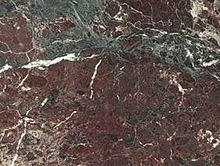Rosso Levanto

Rosso Levanto is the name for a natural stone that is quarried near Bonassola in Liguria , Italy . The quarry is located about 10 km from La Spezia and is named after Levanto , the last of the five villages in the Cinque Terre , which is right next to Bonassola. The rock originated in the Jura 160 million years ago and the transformation, the serpentinization , took place 3 million years ago ( Upper Tertiary ).
Rock formation
Serpentinites arise from deep rock in the earth's mantle , from peridotite that has been metamorphically impressed. The olivine contained in the peridodites is completely transformed into serpentine minerals by heat and pressure and the original rock is shattered. The cracks and crevices that arise in this process are filled with calcite , which appear as white veins. In the process of serpentinization , the original rock is completely transformed.
Rock description
This natural stone is structured in its reddish to gray-green base mass by numerous white and white-gray calcite veins. The color of Rosso Levanto varies between purple to blood red and greenish to gray-greenish. Even with an appropriate selection of the natural stone to be used, green deposits occur in the reddish stone. Rosso Levanto is one of the rare red serpentinites that are otherwise green in color. The red color is due to the fact that the iron contained in the original rock has been oxidized to hematite . If the rock is exclusively green, it is traded as Verde Levanto , which is now mostly used as an aggregate for the production of agglomarble . It used to be used from building blocks.
use
It is a historically significant natural stone that was used in clerical and secular buildings throughout the Mediterranean during the Middle Ages . Mainly balustrades, columns, chimneys, wall coverings and stairs were designed inside these buildings. The stone is also used in sculpture and in handicrafts with bowls, vases and other designed objects.
This natural stone is not resistant to frost, salt and the polish is attacked by chemical aggressors and weathered outdoors.
Rosso Levanto appears in stores with different names such as Rossa Levante, Rosso di Lepanto, Rosso Levantino, Rouge Lewanto, Red Lepanto, Red Levante marble, etc. However, it is not marble in terms of geology . However, it is customary in trade to classify polished rocks only as marbles or granites.
Individual evidence
- ↑ a b c Karlfried Fuchs: Natural stones from all over the world, discover, determine, use. Sheet 147. Vol. 1. Munich (Callwey) 1997, ISBN 3-7667-1267-5 .
Coordinates: 44 ° 11 ′ 45.5 " N , 9 ° 35 ′ 31.3" E

